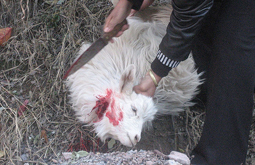More space but too stressful
In Bukhara, in Uzbekistan, for instance, there is a farm with more than 10,000 sheep. For the Karakul sheep herding is much less stressful than caging is for other fur animals. The real cruelty lies in the “harvesting” of the fur. Because the unique curly fur of this sheep begins to straighten only three days after birth, the lambs are slaughtered and skinned at only 1 or 2 days of age. The mother sheep, robbed of their lamb, are left behind, suffering with full udders and searching incessantly for their offspring.
Cruel slaughter methods
Fur production involving Persian or Broadtail sheep is even more macabre. This exceptionally soft fur stems from unborn Karakul lambs. The mother sheep is killed 15 to 30 days before the lamb would be due. The sheep are ritually slaughtered, without anesthesia, and left to bleed to death. The belly of the dying mother sheep is then slit open and the still developing fetus is removed, killed, and skinned. Normally, the first three lambs born by a mother sheep are slaughtered after birth. The fourth lamb, however, is removed from the womb of the mother sheep for its fur.
The fur-producing industry often claims that Karakul lamb fur is only an auxiliary product of sheep breeding. However, given the high prices to be achieved with fur, it is the lamb meat that is the actual auxiliary product. Moreover, the fur industry often states that Persian lamb fur stems exclusively from natural premature births. It takes 26 to 30 fetus furs to make one Persian fur coat. Customers pay up to CHF 30,000 for such a coat and approx. 4 million such furs are produced annually. The rate of natural premature births among Karakul lamb, however, is only 5%.

